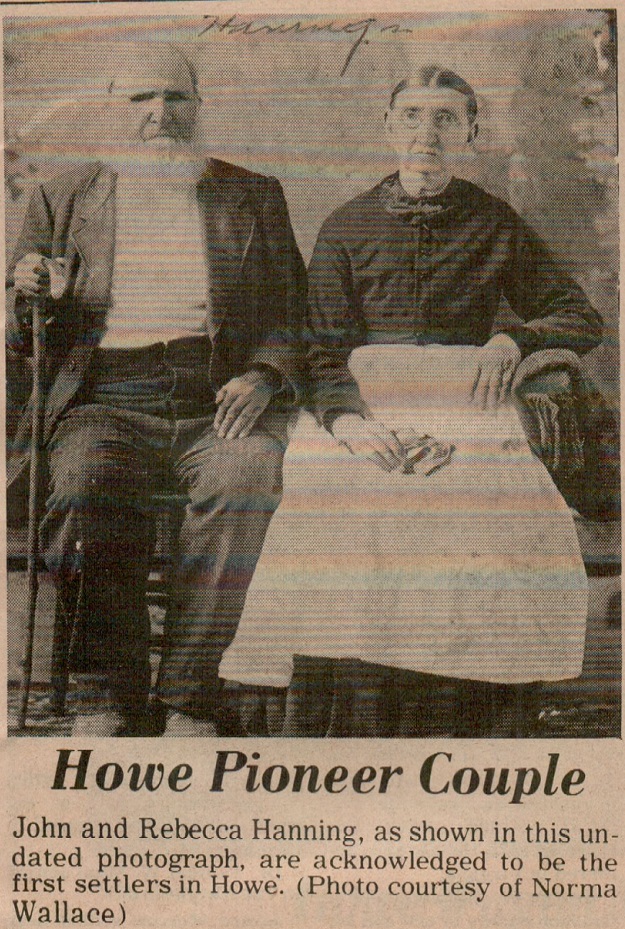 Sherman Democrat July 4, 1976 America Always Edition  The Howe Enterprise Thursday, November 16, 1972 pg. 1 HANING FAMILY HISTORY IN HOWE AREA ORIGINATED IN 1848 by Norma Wallace (condensed from original) Jabez Haning was born September 3, 1827 in Washington County, Pennsylvania, the son of Aarron and Rachel A. Haning. His family lived there until 1845 and in 1846 moved to Texas, and while enroute to Texas and in Red River county, Texas, his father, Aarron Haning died. Jabez Haning and his wife, along with his mother and brothers and their families settled in the Howe community area about 1848, and it was in Howe where Jabes Haning first built his cabin home and became one of the very early pioneer homesteaders in the area. JabeZ Haning continued enroute to the Grayson County area along with his mother and two brothers, Aarron Haning, Jr. and Henry Haning. These persons are listed on the 1850 Texas census as being the #21 family coming to Texas with the Peters Colony of Texas; another brother, John Haning, migrated to the colony as the a family man prior to 1848 and on the 1850 Texas census is listed as family #26. Texas in 1841 was a Republic and as stated in Seymour V. Connor's (State Archivist, 1953 and of Lubbock, Texas) "The Peter's Colony of Texas" - "Texas was a sovereign nation, among sovereign nations, independent, proud and bankrupt!" Even after the victory of the Alamo in 1836 and in the year 1841 and while Sam Houston served his second term as President, the population of Texas was only about fifty or sixty thousand; there were a few cities, constant Indian raids, Mexico's threat to reconquer Texas, the United States and the slavery question; money was scarce and land values very low. Texas officials, in an effort to do something about her dilemma in 1837 introduced the Texas Land Policy, giving Army servicemen with three months service 320 acres of land and those with up to 12 months of service or longer, 1,280 acres as well as came grants to individuals known as Headright Grants, all with certain stipulations. The Third Headright Grant Act was passed on January 4, 1838, providing grants of land to persons immigrating to the Republic between October 1, 1837 and January 1, 1840, to receive 640 acres per head of families and 320 acres for a single man. "The Republic asked that colonies of brave persons be established and come to this crude frontier land and the colony would be supervised by a Company, which would erect and maintain forts for protection from the Indians, and in return the Colony for its service was to receive three million acres of land from Texas Congress House Journal, February 10, 1841). Thus, the Peters Colony of Texas was formed February 4, 1841. This emigration to Texas from the Ohio River valley in the years 1841 - 1848 consisted of farmers, small land owners, merchants and artesians for a total of 1,787 settlers who were bona fide colonists in the Peters Colony of Texas." John, JabeZ and Henry Haning were pioneers of Dutch descent who married Irish-Scotch and were referred to as "Pennsylvania Dutch." They were in Howe to greet the railroads. It was JabeZ Haning and his wife, Harriett, who saw the need for transportation for the abundance of grain and farm products that grew so well on this rick, black soil, the need for these commodities to be shipped to consumers and the need for the citizens of Summitt (Howe) to sell their products. The community was prospering with schools, colleges, churches, saddlery, bank, grain company, doctors, lawyers, carpenters, preachers and saloons. On May 15, 1876, Jabez Haning and wife, Harriett, executed a Dedication Deed to the town of Howe which stipulated that lots were to be laid off with streets and alleys under the name of "Howe" according to the town plan drawn by James O'Connell. The first streets were named Denny, Davis, Haning Avenue, O'Connell, Tutt, Kosse and Allen streets. The deed also stipulated that the Houston & Texas Central Railway Co. make their depot and station on the land designated for their use as shown in the plat map. This deed was filed with the Grayson County Clerk, G.A. Dickerman, on June 17, 1876. Prior to 1876 the town was known as "Summitt" because of its location on the highest elevation of ground between the Red River and the Gulf of Mexico. The later name of "Howe" was associated with the coming of the railroad, in honor of Major F.M. Howe, the first general superintendent of the Houston & Texas Railway Co. An application for incorporation of the town of Howe was filed with the county clerk on October 11, 1884. The election had a total of 40 votes - 37 for incorporation and 3 against. Howe was incorporated on October 15, 1884. Jabez Haning died in April 1883. Many of the Haning family are buried in Hall Cemetery, west of Howe Howe History Susan Hawkins © 2024 If you find any of Grayson CountyTXGenWeb links inoperable, please send me a message. |